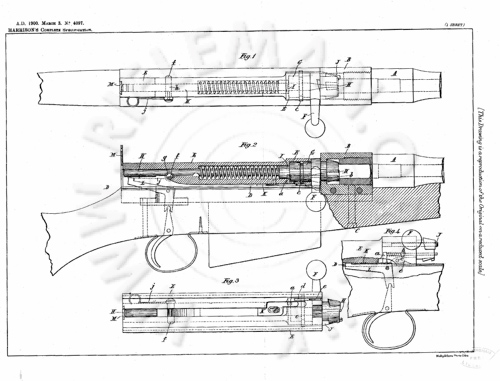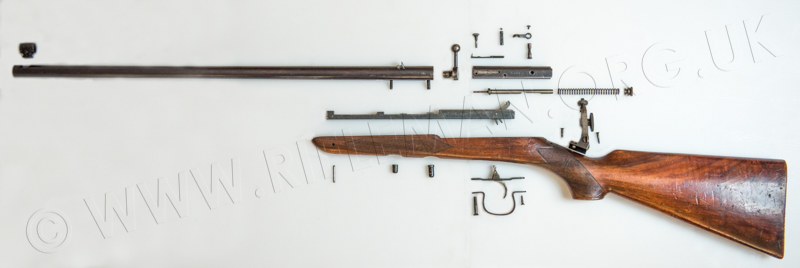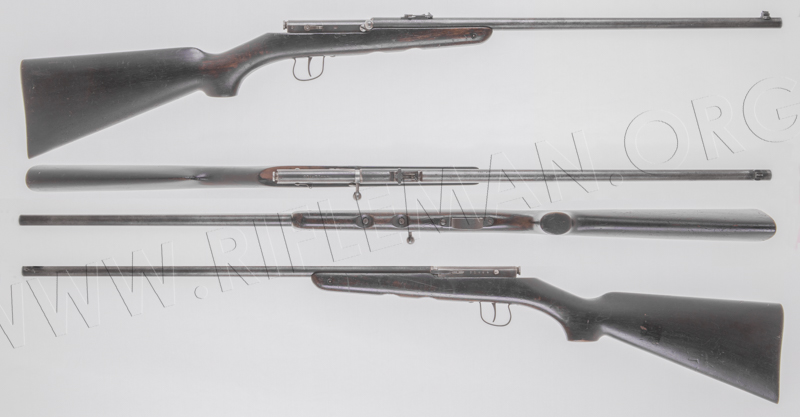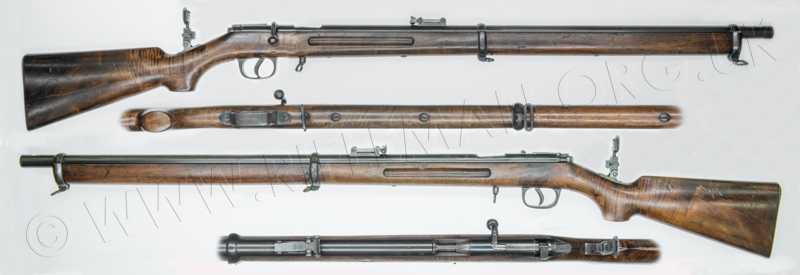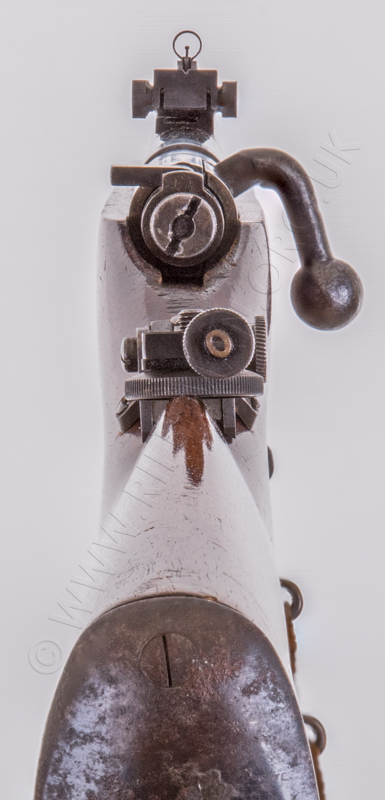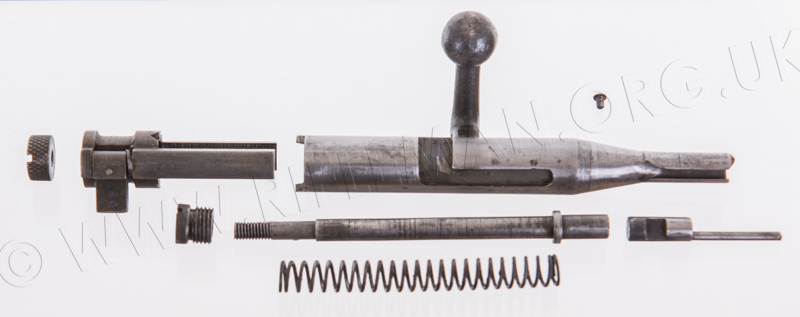THE "CERTUS" RIFLES by Cogswell & Harrison
Page continuing under construction as at 20/10/24
Please be aware that some specialist imagery may take time to load.
This site is for dedicated researchers and is best viewed on desktop.
The famous London firm of gunsmiths - Cogswell and Harrison - produced this .22 rimfire rifle shortly after the formation of the civilian rifle club associations; particularly the Society of Miniature Rifle Clubs in 1903. The rifle had earned a quite reasonable reputation in miniature calibre target shooting circles by 1906.
Those rifles illustrated on this page are all in the 30,000 production series, and would have been manufactured between 1906 and 1907, which approximately covered rifles serialled between 29,000 and 41,000.
THE EARLY MODELS USED HARRISON'S PATENTED BOLT ACTION
This was the frankly unexpectedly strong action configuration that Cogswell & Harrison utilised on rifles of all calibres, from full-bore hunting rifles to small-bore target and sporting models. Here covered are only the small-bore rifles.
Below: the unusual "on rails" forward-locking bolt-action.
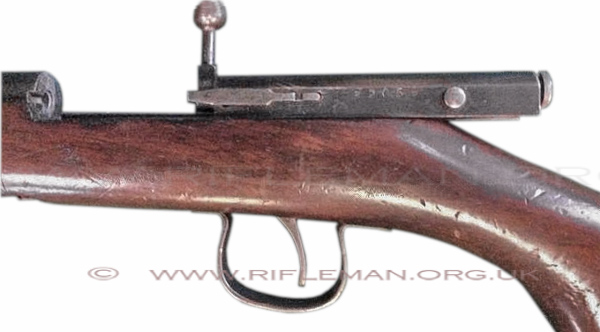
Even today forward locking systems have usually provide the more accurate actions.
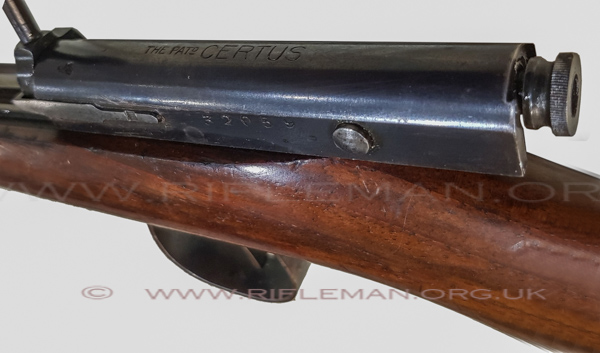
In a section in his book Rifles of the World, John Walter wrote that "the unique turning-bolt action patented in March 1900 by Edgar Harrison was made in small numbers." He stated that .......
"Named for the company's telegraphic code-name, the Certus mechanism was built around a stubby rotating bolt-head set into a reciprocating block. When the handle was lifted, disengaging the locking lug from the receiver, and block could be slid backward along rails set into the stock.
The extractor and ejector were built into the bolt-head and block respectively. The safety catch
was a radial lever on the right rear side of the block, and many guns had readily detachable barrels.
Production most likely ceased in 1914 with the commencement of the First World War.
A Certus Expert Marksman's rifle was offered in the Cogswell & Harrison catalogue of 1900 in plain or engraved versions. It had a walnut half-stock, chequered on the wrist and fore-end. The rear sight was an exchangeable 'V or peep- plate sliding in a channel on the back of the travelling block. "
Walter was perhaps technically incorrect in describing it as a turning bolt, as only the locking bolt-head rotated. The true turning bolt appeared on later models illustrated lower down this page. The mention of the rear-sight mounted on the rear of the breech-block applied only to those few of the earliest Certus rifles. The rear-sight soon became a traditional barrel-mounted "V" in a dovetail on the sporting rifles, or a tangent leaf as an option, perhaps for those more inclined to target shooting. The latter type was as most often seen on such as the competing BSA Model 12 and Vickers Martini rifles.
Below: a contemporary advertisement promoting their "Expert Marksman" and "Rook & Rabbit" rifles, and illustrating the rear-sight mounted on the rear of the bolt, and available elements. At this time the standard .22 Marksman cost two guineas and the engraved and better finished model one guinea more. The centre-fire Rook & Rabbit rifles were three guineas plain, five guineas in better finish, and eight guineas in best quality with a "handsome" stock.
A guinea was one pound and one shilling, or about one pound and five pence in decimal terms, having an alarming equivalent value of nearly two hundred pounds in this third decade of the 21st. Century.
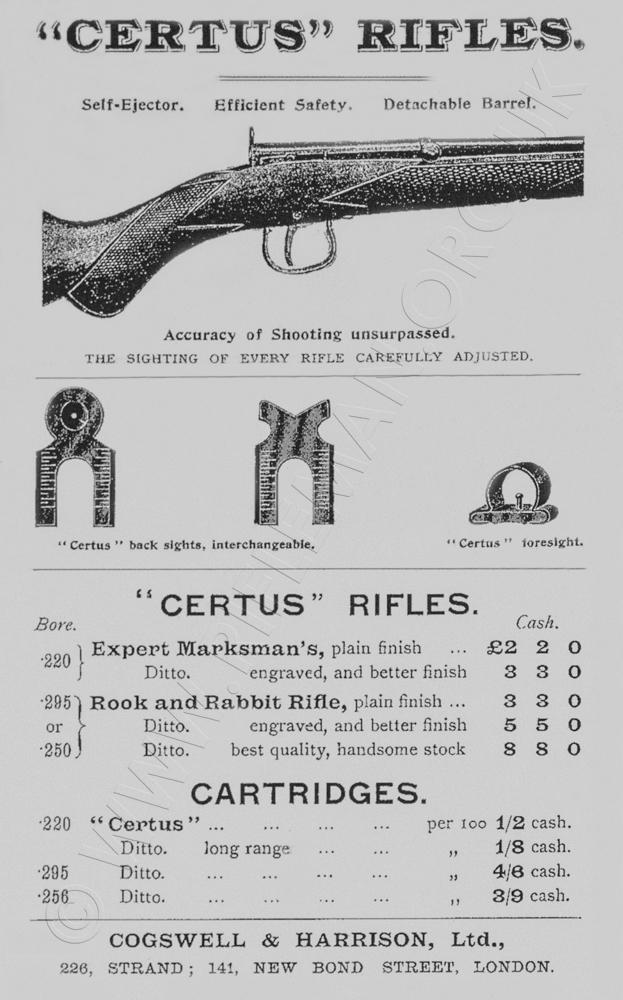
In relation to this rear-sight configuration, L.R. (Luke) Tippins, a contemporarily famous service shot, gunsmith and well respected author, wrote in his 1903 book on "Miniature Rifle Shooting" in the chapter covering such rifles......
"Messrs. Cogswell and Harrison make a rifle in various sizes which they call the "Certus". It can be had in at least two calibres for sport as well as miniature practice, but for the latter is made in .220, .297/.230, and .295. It is well made and very accurate, within the limits of the cartridge. It costs two guineas or three guineas in .220; and three or five guineas in .250 or .295.
It is a bolt gun, easily cleaned from the breech, and easily dismounted. Its drawback is that the sight is fixed on the bolt, and travels with it. This is a very poor principle indeed for accuracy. The sights are interchangeable between aperture and V, but both are fixed in the same place. This is not a good feature, because the correct distance from the eye for an aperture backsight is by no means suitable for a V. Not only is clear definition almost impossible with the V so near the eye, but the effort to get it is injurious to the eye. The makers say that the shooting with the aperture sight is "generally from 25 to 40 per cent. better than with the ordinary or open V sight". With the V so near the eye as it is on this rifle this is probably true, but with a good V well placed the difference is nothing like as great as so stated. The diagrams published as made at 100 yards are a good bit better than the .22, .297/.230, or .295 cartrdiges are usually capable of making at 100 yards; but as the calibre of the rifle that made them is not stated, it is not probable that the rifle was a miniature at all."
With criticism such as this it is unsurprising that these sights were replaced before long.
Returning to another reference within John Walter's write-up, the extractor fixing is actually located entirely within the left-hand side of the bolt body in a tapered dovetail. The extractor's hooked extension passes by the turning bolt-head, which is eccentrically rounded, forming a cam that only bears against the extension as the bolt handle is turned into the horizontal locking position - holding the hook away from the chamber. As the handle is rotated into the vertical, to open the breech, the bolt-head cam unlocks the breech-block and clears the exctractor extension, permitting the extractor hook to spring back behind the fired cartridge-case rim, withdrawing the case as the bolt is drawn rearwards.
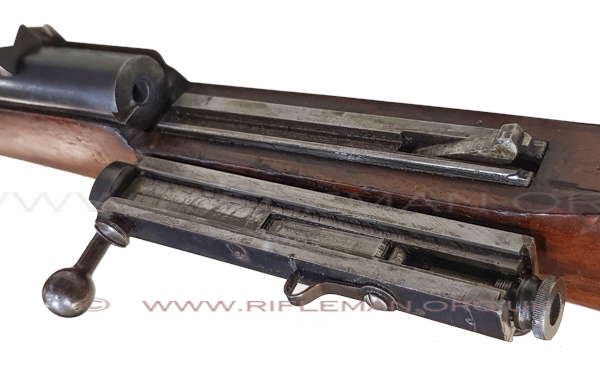
We illustrate the patent, application no. 4097, of 1900.
Click image to bring up hi-res file and magnifier
In Graham Cooley and Jon Newtons excellent book on Cogswell & Harrison (ISBN 0-948253-83-5) There is a quotation from a C&H catalogue advertisement of comment made by the Editor of the Land & Water journal; this was in early April 1900, and he wrote "The rifle action is not one that can be likened to that of any existing weapon, military or otherwise upon the market"; adding that "the diagram (of a shot group) is first rate".
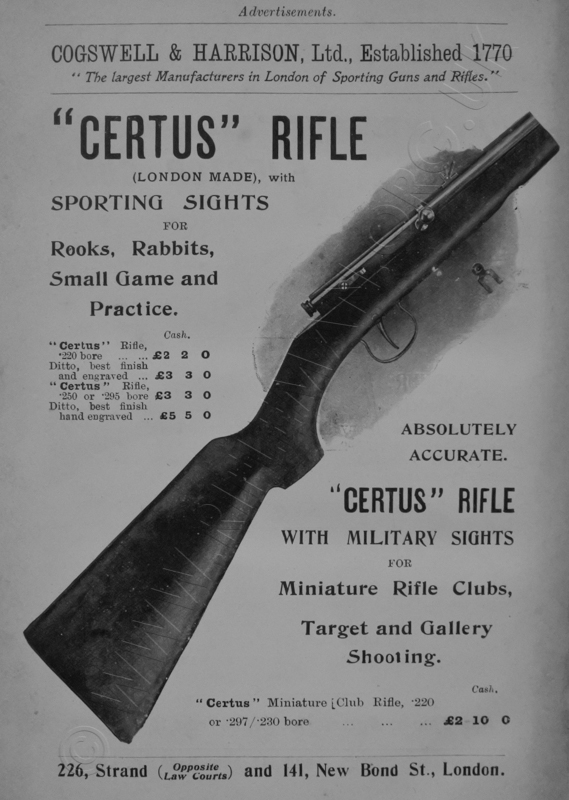
In an article on Miniature Rifles in 1906, H. Marks, one of the founding fathers of the Society of Miniature Rifle Clbs and authour of the book "Citizen Rifleman" also of that year, wrote as follows:
"Messrs. Cogswell & Harrison are responsible for the introduction of the Certus rifle for miniature target shooting. It is constructed to shoot the .22 rim-fire short and long cartridge, and is a single-loader with a bolt-action. The shoe which carries the bolt and trigger mechanism is fixed to the barrel ; the stock and fore-end are of one piece, and the barrel and shoe, together with the bolt, can be readily detached from the stock by the removal of a pin, which enables the shooter to pack the rifle away in a small compass. Of simple construction and low price, we cannot apply too stringent a view to the workmanship. On the whole it is an efficient weapon, and as far as concerns low-priced small-bore miniature rifles, the Certus is probably one of the best of its class. There are several patterns of sighting. The standard pattern consists of an upright strip of metal, which works in two grooves fixed in a bed upon the barrel, and is lifted up and down for the different ranges, which are marked upon the front. The sight is made with a " V," and is held rigid by means of a pin.
This method of sighting equals anything that is applied to American and Continental weapons, but it falls below the best British efforts in this connection."
THE LATER STANDARD MODELS
The earliest .22 Long Certus we have available carries serial number 31442, with fine scroll or foliate engraving to the breech-block and barrel's breech area, and chequered wrist and fore-end. However, we are aware that the old Pattern Room Collection, now located in the National Firearms Collection at the Leeds Royal Armouries, holds a similar scroll-engraved rifle serial no. 30421, of ca.1905, in .400 calibre - Object no. PR6104.
Hover over or Click image to bring up hi-res file and magnifier
The same rifle is shown disassembled, with stripping detail following.
Hover over or Click image to bring up hi-res file and magnifier
The tube fore-sight is of the BSA Model 19 type, with an internal flip-over ring or blade option. The standard rear-sight is the aforementioned dovetailed "V"-notched block just under two inches forward of the breech. A BSA Model 8 folding aperture rear-sight has been retrofitted, probably for target shooting.
The separate barrel has two threaded bedding pins at the rear, which drop through holes in the carrier beneath. The deeper rear section of the carrier bears both the machined dovetail-like rails on which the breech-block slides, and the pivoted trigger sear at the very rear end. The carrier is bolted to the barrel by the two large domed nuts seen beneath the fore-end wood. The barrel and its carrier, are then placed into the fore-end. The domed bolts simply pass through plain holes in the wood, and take no part in the bedding. The barrel and carrier are held into the fore-end simply by a long bolt that also holds the front of the trigger guard, and by a plain pin near the nose of the fore-end that passes through a hole at the front of the carrier.
The trigger is pivoted in a plate that is recessed into the fore-end, and is held in place by the single bedding bolt and the wood screw fixing the trigger-guard. The upper lever of the trigger locates into the fork at the base of the sear lever in the carrier.
The breech block components can be seen more clearly if the image is zoomed.
The bolt/breech-block is sufficiently unusual that repair and replacement of parts can be tricky. Unlike many other rifles, disssembly instructions are not widely publicised; so this has been covered here in some detail.
Stripping is achieved by the removal of the bolt-head locating pin, when the bolt-head can be withdrawn forward; the extractor can then be driven out of the block as previously described. The knurled knob (a male nut) at the rear of the block has a hole through its centre that allows the rear end of the long striker to protrude and be seen when the action is cocked. It can simply be unscrewed and removed, as it is not holding any striker spring pressure.
That pressure is held by the safety-catch cross-pin that passes through the breech-block, and is flush with either side plate. But there is another cross-pin that passes through the centre of the breech-block, but is barely visible. The left- hand end of this pin has a tiny locking grub-screw ( 6BA) that prevents the pin from rotating, as the pin has a flat that clears the rails of the bed on which the block reciprocates. With the grub-screw carefully removed, the pin can be driven out with a brass punch to prevent damage to the blued finish at either end. Take great care; many of these parts are extremely hard, brittle and easily broken.
This pin can just be seen in the earlier image, above the patent details, where the breech-block is laying inverted beside the rifle. On some later rifles it appears that it is perhaps not intended that this pin be removeable in the normal course of events.
With this pin out, the striker spring pressure is now only held by the safety catch fulchrum pin. The machine screw holding the catch lever should be removed and the lever taken off, leaving the pin able to be carefully driven out with the punch.
However, the spring pressure will not permit this until the spring is compressed. This can best be done by putting a hardwood dowel, slightly less in diameter than the front bore of the breech-block, vertically into a vice. The block should then be held over the dowel with the protruding firing-pin resting on the top of the dowel. Pressing down on the block pushes the firing-pin and striker back into the block, compressing the spring and relieving the pressure on the striker. When pushed back far enough, a groove in the striker is moved back to line up with the safety-catch fulchrum pin, which can then be tapped out. If the pressure is then slowly released on the striker and firing-pin resting on the dowel, the spring is gently uncompressed, and the striker with its spring can be withdrawn from the block.
Reassembly, as they say, is by reversal of this procedure!
A slightly later model that has been kindly loaned to us is in the rarer .297/.230 Morris centre-fire calibre.
This rifle is serial number 31884
Hover over or Click image to bring up hi-res file and magnifier
The extractor has an extension and hook considerably wider than that of the previous rimfire model, the .297/.230 Morris carridge being centrefire, larger in rim diameter and thicker in the rim. See the Morris Aiming Tube and the Martini Metford MT carbine.
The domed head to the rear of the breech-block is the end of the pin that is the fulchrum for the safety catch.
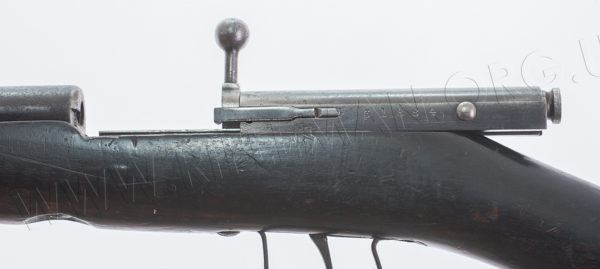
The other end of that pin is squared off and a sprung safety lever is held onto it with a small domed-head machine screw. The lever rotates through 180 degrees, and the nib on its curled end locates into the two circular recesses at either side of the fulchrum.
The knurled and wide-slotted screw head beneath the bolt-handle knob is on the cross-pin that holds the bolt-head into the bolt body.
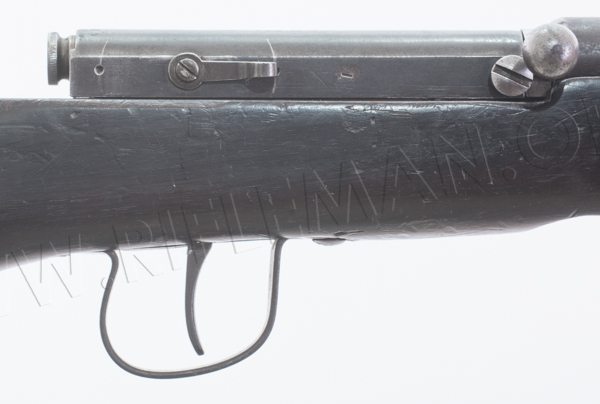
The barrel of those Certus rifles we have seen is usually roll stamped
" COGSWELL & HARRISON LTD 141, NEW BOND ST . & 236, STRAND, LONDON. "

The breech blocks are stamped
" THE PATD CERTUS "
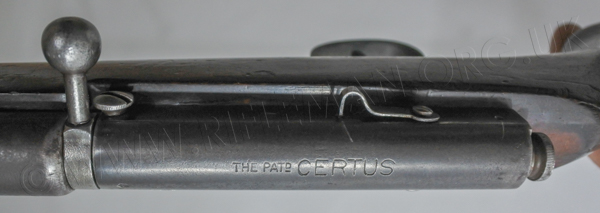
The calibre of this model is stamped beneath the company address on the barrel.
.297/.230
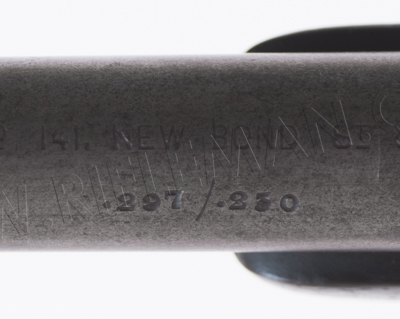
A close-up image of the extractor shows the holding dovetail to the right, with an angled notch to take a chisel punc to drive the extractor out of the breech-block for replacement if broken. The forward extension passes across the narrow bolt-head at the point where, breech closed, it is clear of the camming, allowing the extractor hook to rest in the extractor groove.
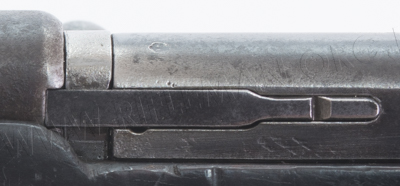
The rifle has a barleycorn type fore-sight mounted on a dovetailed block.
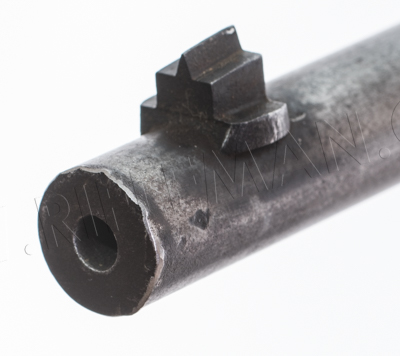
The rear-sight is a tangent leaf that can be raised for long range use, when the elevation slide takes the place of the short range "V".

This example has range scale lines, but is not actually calibrated.

SPORTING MODELS - WITH TAPERED TURNING BOLT
The tapered bolt action was used for various sporting models of Cogswell & Harrison's rimfire rifles, and later for some military style training rifles.
The example illustrated below is serial no. 33152


The disassembled rifle
Hover over or Click image to bring up hi-res file and magnifier
The trigger mechanism; right .....
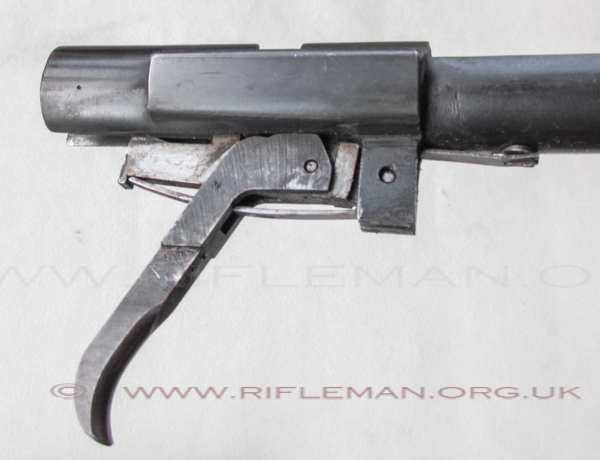
..... and left.
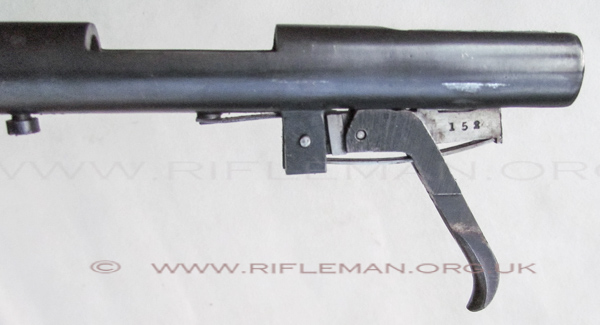
...... and from beneath

The barrel's rear-sight and proof marks
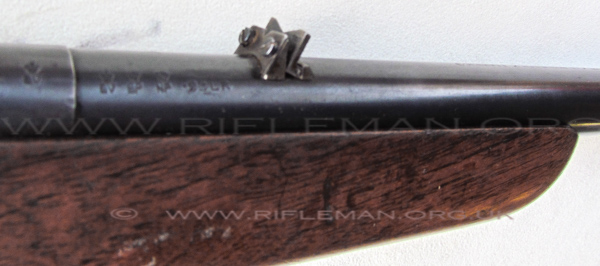
The rifle's fine pillar dovetailed fore-sight, perhaps originally a barleycorn that has been filed back to an owner's liking. This probably justified the fitment of a fore-sight protector!
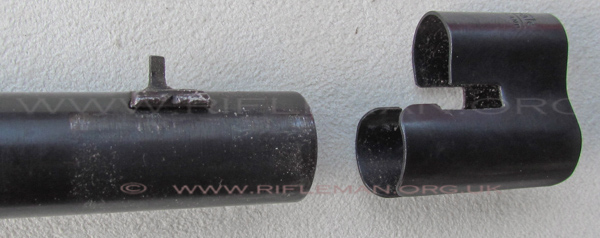
The rifle's serial number is stamped under the trigger-guard in the customary style of C & H Ltd.

The action from above, detailing the safety catch and still vertically turned-down bolt-handle. Bolt closed.
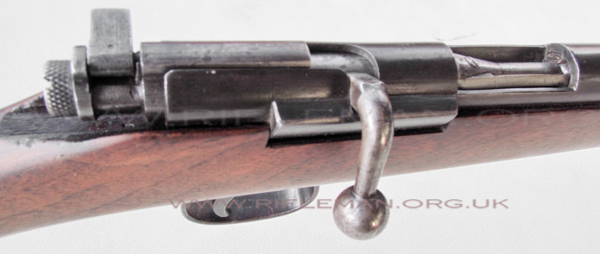
And with the bolt open.
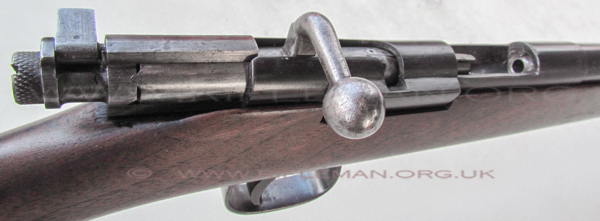
The action and bolt-way with the bolt removed. The ejector lug is at the bottom of the loading platform, and the trigger's sear and lever is central just astern of the bolt-handle locking slot.

The bolt-head tapering to the narrow front section, showing the recessed face, top mounted extractor and firing-pin set to the right-hand-side.
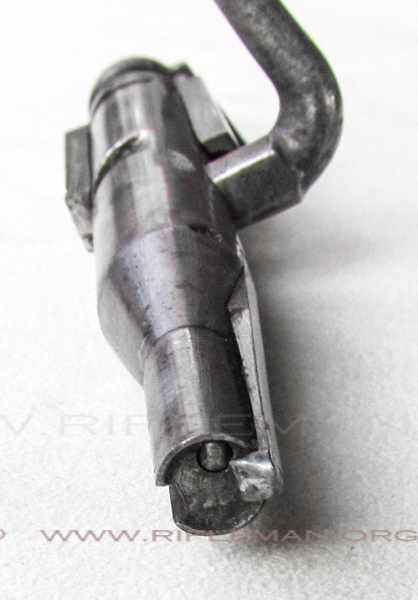
The bolt from beneath ........

.... and from above
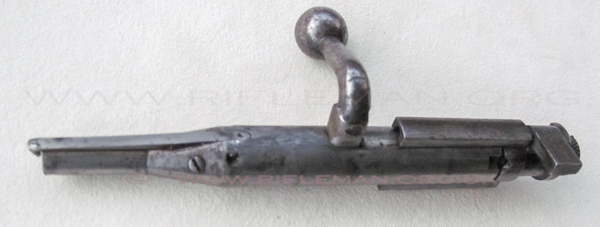
The rear-sight: this is not the first we have seen that is dovetailed in leaning forward.
In use this badly reflect light into the shooter's eye, and we would expect it to be leaning rearwards to shadow the face of the leaves.
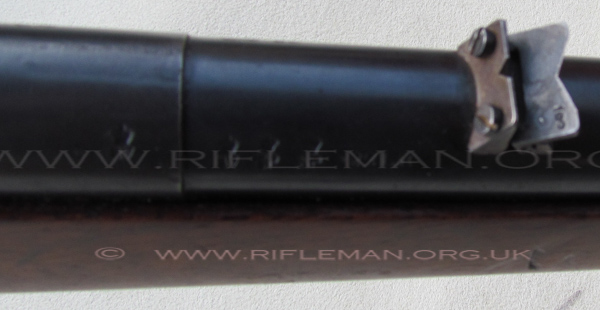

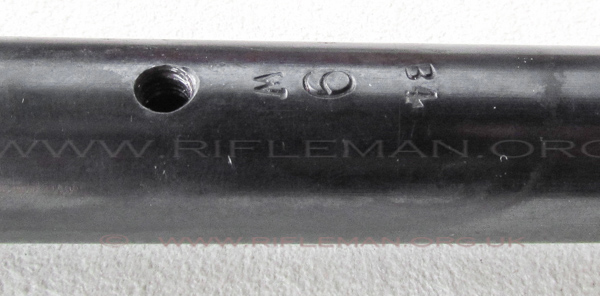
THE "PROTOTYPE" TRAINING RIFLE
The original Pattern Room tag label for this example
shows the unusual prefixed serial number " W 2794 "
and the rifle is described as the "NEW CERTUS";
but the trigger-guard carries the stamped serial number 33324.
Images taken by Rifleman by courtesy of the Enfield Pattern Room
Hover over or Click image to bring up hi-res file and magnifier
This cadet style rifle has a bolt action somewhat resembling that of the the War Office Pattern Miniature Rifle of 1906, except for the significantly tapered bolt-head; this could well have been due to the specification, issued by the War Office, to which submitted designs were required to conform.
This pattern rifle was a proposal for a training arm that could have afforded Cogswell & Harrison a highly profitable contract, had it been successfully trialled and approved. It has the contemporarily expected full-length military style furniture, and is in .22 rimfire calibre.
The rifle has an overall length of 44½ inches and a weight of approximately 8lbs. 3ozs.
The Pattern Room's object number for the rifle is PR.15 - very early in the current recording system that is in use for those exhibits in the original Pattern Room collection since being transferred from Enfield via the Royal Small Arms Factory, then Nottingham based, into the care of the Royal Armouries at Leeds in 2005.
The rifle was originally handed in during the Home Office Firearms Amnesty of 1988, in February 1989. It is most fortunate that it was recognised as historically significant and not destroyed, as were so many others.
Confirmation of the intention for the design can be found in a comment in the chapter on 'The .220 Calibre Rifles" in the 1915 First Edition of "Rifles and Ammunition" by H. Ommundsen and E.H. (Ernest) Robinson. In this historical write-up on the early days of the Society of Miniature Rifle Clubs and the development of the War Office 1906 Pattern Miniature Rifle, and contemporary miniature rifles in general, it is stated that ...
"There was also on the market the "Certus" rifle made by Messrs. Cogswell and Harrison, a model which has considerable interest because it foreshadowed in general design the cadet rifle which was soon to be fathered by the War Office."
The tapered mid-section of the bolt can be seen in the next image of the action from above, leading to the narrow forward section of the bolt-head.
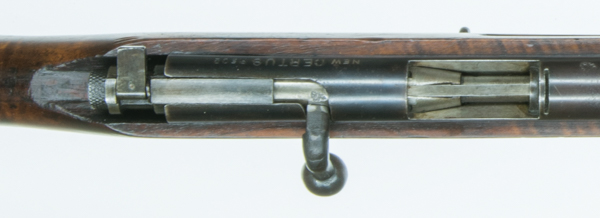
The simple form of the loading platform of the receiver, and the top mounted extractor are particularly close to hte final configuration of the first War Office miniature rifles; as is the gas bleed slot over the chamber.

The bolt-head is recessed for the head and rim of the .22 cartridge.
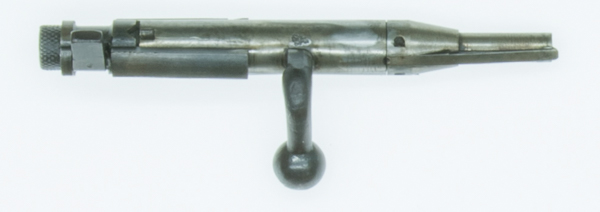
The pair of substantial locking lugs of the rear-locking action can be seen behind the significantly down-turned bolt handle, which curves rapidly through close on ninety degrees.

The Mauser-like flip-over safety catch at the rear of the bolt is also close to the design of that for the War Office miniature rifle.
Left: the safety-catch and cocking-piece
 ..................
..................
Above right: the recessed bolt face,
top mounted extractor, and right-hand positioned firing-pin.
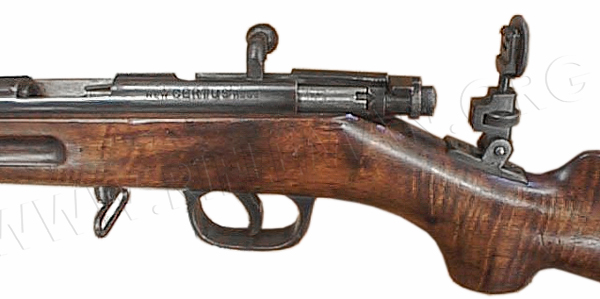
What we had presumed to be a one-off company-made aperture folding rear-sight for these proto/trials rifles has been fitted above the wrist. To confound our theory, a New Zealand collector has advised us of a Belgian single-shot bolt-action .22 rifle he has acquired that is fitted with one of these sights. There has presently been no explanation for its appearance, but it has presumably been transferred from another C&H rifle. We have yet to see these sights either advertised or mentioned in any contemporary literature, and have also yet to see another example - but perhaps you know differently.
The stamped range figures are overlarge for the width available on the elevation slide, but it appears to be calibrated up to 300 yards.
The aperture eyepiece is marked for Cogswell & Harrison - London,
and is of the type where windage adjustment is made by use of the eccentric mount of its fulchrum. There is an uncalibrated scale engraved on the base of the eyepiece.
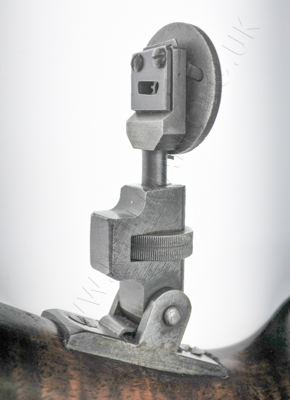 ......
......  .....
..... 
The tangent rear-sight is, to all intents and purposes, to the design of that engineered for the War Office miniature rifle, and is similarly calibrated for 25, 50, 100, and 200 yards.
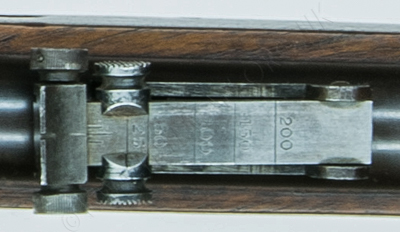
The fore-sight is missing.
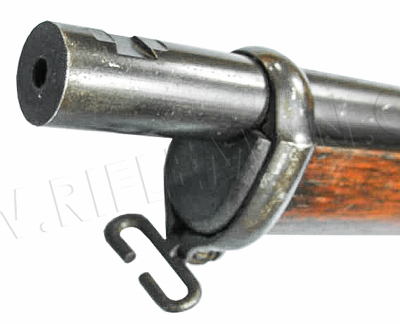
Another similar cadet style Certus rifle came to our notice early in 2024.
This example was spotted in the hands of its owner being shot on a range also used by an observant member of the H.B.S.A. An approach was made that resulted in permission for the member to take a number of photographs that have been kindly shared with Rifleman.

Essentially identical to the prototype pattern room rifle in the N.F.C., the rifle differs mainly in slightly shorter fore-end wood, affording more free barrel ahead of the front barrel band, to which a barrel lug has been added. The muzzle has a short section of reduced diameter that permits the attachment of a 1907 pattern Enfield bayonet.

The rifle has been photographed with the bolt removed.
Hover over or Click image to bring up hi-res file and magnifier
The serial number of this rifle is 33872, aproximately five-hundred and fifty rifles later than the Pattern Room example. It is difficult to gauge its date of manufacture in relation to the rifle in the Royal Armouries, but it is, at a guess, likely to be around a year later. We have been advised by the owner that he believes that circa 1906-7 the rifle was not permitted to be used in competition, probably by the Society of Miniature Rifle Clubs, because the barrel was capable of being fitted with a bayonet. If you have any knowledge of such a rule we would be delighted to hear of it.
" COGSWELL & HARRISON..... LONDON. "

The Certus later became available in a more familiarly known shortened fore-end target style stock and with the same modified bolt action.
TARGET MODEL WITH TAPERED BOLT
Serial No. 33354
In many respects this rifle, only thirty serial numbers on from the New Certus military model, is identical in most respects other than the fore-end length and the addition of a folding rear aperture sight. Even the pistol grip and fine tiger-striped furniture appear the same. The production dates are therefore also very close.
Hover over or Click image to bring up hi-res file and magnifier
Again, this rifle shows significant similarlty to the War Office Pattern rifle,
but is altoghether more sun\bstantial; the barrel being rather heavier.
The tapered bolt from the right-hand-side showing the Mauser/ War Office Pattern Rifle style flip-over safety catch .........
........ and from above.
Below: two "stacked" images (for greater depth of field focus) of the rifle from front and back.
The action with bolt open and folding aperture sight raised

The rear tangent leaf sight effectively to the Enfield Royal Small Arms Factory drawing for the War Office Pattern Miniature Rifle - shown beneath.
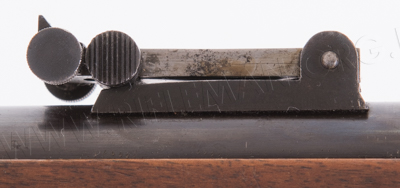 ..........
.......... 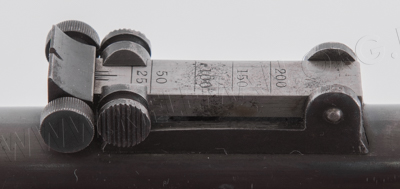
From R.S.A.F. Drg. No. 2321A

The flip-over fore-sight with blade (left) and short tunnel protected bead (right)
 ........
........ 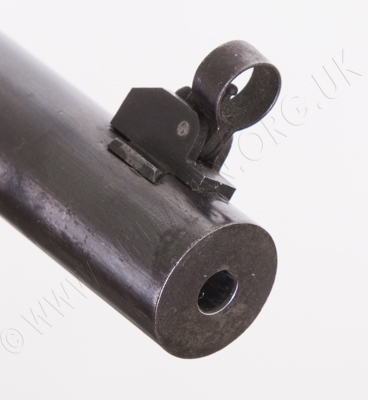
The folding W.W. Greener rear aperture sight to Patent no. 10555.
Greener's 1914 Catalogue - page 28
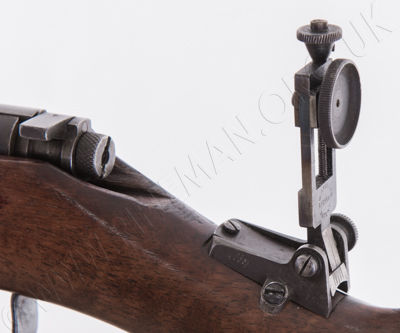

It is interesting to note that Cogswell & Harrison also marketed full-bore calibre centre-fire bolt-actioned rifles and even a single-barrel bolt-actioned 12 bore shotgun under the "Certus" name. Seemingly, by the 1920s, Certus had become more of a trade name representative of Cogswell & Harrison than the name of a specific firearm.
Below: the 1906 general Advertisement in Edgar Harrison's own book
"A Dissertation on Guns and Shooting"
The Company then had premises in both New Bond Street and the Strand.
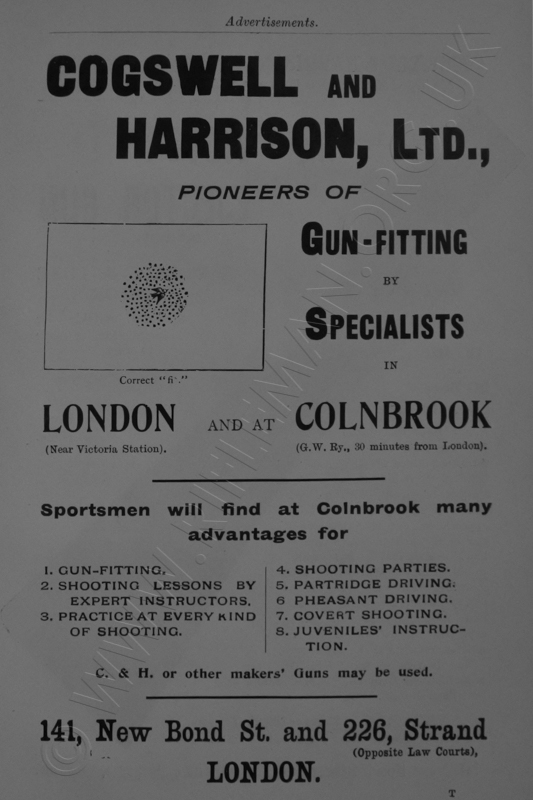
On the 1st. January 1896 the journal "The Sketch" carried an article by an unnamed author who was taken by his friend to visit Cogswell and Harrison's main premises in London. The piece was entitled .....
A VISIT TO A FAMOUS GUNMAKER'S
" I am going", said a friend, "to have my gun fitted to me".
"Have your gun fitted to you? I remember a man in a play who was going to get measured for an umbrella, but a gun?"
"Come along," he replied, "and you shall see".
..We went to Victoria, and, a little way from the station, arrived at the factory of Messrs. Cogswell and Harrison. We walked through a formidable gate, put out cigars, to comply with the imperative notice, and entered a building that looked like a galvanised iron church; it was lined with felt, to deaden the noise, and very lofty; at the end were large white discs. Then was produced a weird -looking gun, with a stock in several pieces, kept together by adjustable screws and aluminium fittings, and my friend began shooting at flying pitch discs which represented pigeons, and, after each shot, the screws were tightened or loosened, till at length the weapon exactly fitted his reach and mode of firing. A great deal was said to me about too much or too little "cast-off", straightness of stock, &c., which, seeing that my study of ballistics never went beyond catapaults and bows and arrows, I did not understand.
..After this my friend declared that he wished to test the accuracy of the rifle just made for him by the firm, so we were taken to "the tunnel". To my surprise, I found that there was a one-hundred-yard range on the premises underground, lighted by electricity, and aerated by a large fan; while there was an ingenious apparatus, invented by Mr. Edgar Harrison, for levelling the rifle with absolute accuracy. At forty, fifty, and one hundred yards, the weapon fired with appalling correctness.
.."Of course", said our guide, "you can go to our ranges at Harrow for open-air test; but you can't test the absolute accuracy so well there as here".
.."I presume you are makers, not merely dealers and repairers?"
.."Come through the works, and you will see". I was punished by getting tired of walking from one large department to another, watching the numerous operations. Some matters seemed to me decidedly interesting. Everyone has heard of the "choke-bore" - of the idea of slightly narrowing the bore close to the muzzle, so as to keep the shot together, and produce a more deadly result. The narrowing is small, full-choke being only one-thirty-thousandth of an inch in a 12-bore gun, and, of course, has to be done very nicely. I found, to my surprise, that paper plays an important part in the operation. The boring is done with a square-edged rod of tempered steel, with a wooden slot as backing. Between the steel and wood are inserted slips of fine oiled paper, increasing by infinitesimal degrees the diameter of the borer and calibre of the bore.
..One feature struck me greatly. A huge mass of finely finished machinery has been put up, with the object of making all the parts of the complicated action interchangeable. [This of course related at that time to the mass production methods introduced by Samuel Colt - Ed].
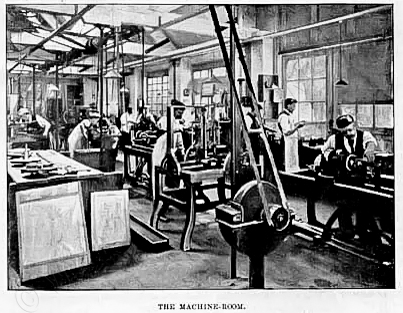
..Mr. Edgar Harrison's patent cartridge-ejecting mechanism, combined with the most approved system of breech closing and locking devices and the ordinary gun-lock movements, appears to a novice to be almost as complicated as that of a watch, although, looking at the whole mechanism and movements from a gunmaker's point of view, the very reverse is the case. However, it is essential that the greatest accuracy of work and greatest strength should be obtained in a fine modern gun. By means of the new machinery, not only will the firm be able to turn out more guns per week than before; but, in the case of an injury to a gun, they can send to the owner a counterpart of the damaged bolt, screw, hammer, plate &c., which can be fitted by any amateur. I am glad to learn, however, that this machinery will not cause the discharge of any of the hundred and twenty men and thirty girls engaged in the works.
..The gun-stocks interested me, for, to my surprise, walnut is the only wood used. It has beauty, hardness, durability, and, above all, straightness of grain, and no wood, not even the oak, can vie with it. In fact, save in the guns manufactured - but not by such firms as Messrs. Cogswell and Harrison - for savages, walnut is invariably used; the savages get beech, and barrels like gas-pipes, and the safest place when the gun goes off is about fifty yards in front of the muzzle. The variation in quality of the walnut is so extraordinary that the rough stocks cost from four shillings each up to four pounds.
..This led me to the question of the cost of the sporting shotgun. Fifty guineas cash is the price of one which represents all that the gunmaker's art can do to make a gun as perfect as the present state of science can suggest, and it is doubtful whether the science has not reached its limits. Indeed, when I looked at one of their "Avant-touts", and handled the piece, and saw how rapid and smooth is the working, it seemed impossible that any further improvement of value is still to be made. Of course, this price covers highest finish and finest stock, &c., and for less than half the price a weapon of excellent quality can be bought either at their establishment in the Strand or Bond Street.
..Of course, cartridges are a vital point, and, in consequence, in order to see that the quality is constant, there was an interesting laboratory, with an electric chronograph, so that tests of velocity, lowness of trajectory, breech-pressure, and recoil, can be made, and nothing left to chance. When upon the cartridge and rifle depends life or death, one is content to feel that there is no element of doubt as to quality.
..I cannot pretend to describe the sporting-rifles, the manufacture of artificial pigeons and swiftsure traps, or the hundred-and-one other interesting things that came under my notice while I wandered, upstairs and downstairs, about the buildings that constitute the remarkable factory from which come guns and rifles whose quality has made the name of Cogswell and Harrison a household word with sportsmen.
One could be forgiven for believing that journalism has changed little in the last hundred and fifty years!
The company is still extant, and has in fact in 2024 reintroduced the "Certus" name with a new range of more conventionally configured bolt-actioned rifles in either .22 Long Rifle or .17HMR.
See " Random Writings on Rifle Shooting" by A.G. Banks,
See this website's Raison d'être
